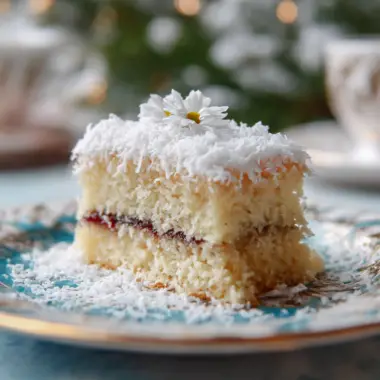The Lardy Cake is a rich and indulgent sweet bread rooted deeply in British baking tradition. Made with generous layers of softened lard, spiced dried fruit, and brown sugar, the cake is folded and rolled multiple times to create beautifully buttery layers with pockets of sweet, sticky filling. Once baked, the sugar caramelizes to a golden finish, making each slice utterly irresistible. While the name might raise eyebrows today, Lardy Cake is a cherished treat in the south of England, often found in village bakeries and local fairs. It’s a perfect nod to the resourceful baking of yesteryears making use of pantry staples to produce something delightfully decadent. It’s best enjoyed slightly warm with a strong cup of tea or coffee, making it a comforting choice for slow mornings or nostalgic gatherings.
Full Recipe:
Ingredients:
-
500g strong white bread flour
-
10g salt
-
7g instant yeast
-
300ml warm water
-
200g lard (softened)
-
200g mixed dried fruit (raisins, sultanas, currants)
-
1 tsp mixed spice
-
100g soft brown sugar
Directions:
-
Combine the flour, salt, and yeast in a mixing bowl, keeping the salt and yeast on opposite sides. Slowly add warm water and mix to form a sticky dough.
-
Knead the dough for 10 minutes until smooth. Place in a lightly oiled bowl, cover, and let rise for 1 hour or until doubled in size.
-
Roll out the risen dough into a rectangle. Spread one-third of the softened lard over the dough, then sprinkle one-third of the dried fruit, sugar, and spice. Fold the dough into thirds like a letter.
-
Turn the dough 90 degrees, roll out again, and repeat the layering twice more with the remaining lard, fruit, sugar, and spice.
-
Shape the final folded dough to fit a lined or greased square baking tin. Cover loosely and let rise for another 30 minutes.
-
Preheat the oven to 220°C (425°F). Bake for 30–35 minutes or until golden brown and bubbling with caramelized sugar.
-
Let cool slightly in the tin before turning out and serving warm or at room temperature.
Prep Time: 25 minutes | Cooking Time: 35 minutes | Total Time: 2 hours
Kcal: 420 kcal | Servings: 8 slices
The Enduring Charm of the Lardy Cake: A Traditional British Treat
The Lardy Cake, a lesser-known yet deeply loved British classic, is a rich, sticky, and satisfyingly indulgent treat with centuries of history baked into every bite. Often described as a cross between a bread and a cake, it originates from the southern counties of England, where it has been enjoyed for generations. Its unique name may raise eyebrows today, but to those who appreciate the art of traditional baking, the Lardy Cake is a prized example of heritage cuisine that showcases simple ingredients turned into something extraordinarily flavorful.
This cake is most commonly associated with Wiltshire, although variations can be found in Hampshire, Dorset, and other regions of southern England. In the past, it was a bakery staple and a celebratory item, often served during special events or saved for Sunday tea. Today, the Lardy Cake holds nostalgic value and is often embraced by artisan bakers and home cooks who enjoy reviving historical recipes with a modern twist.
A Glimpse into Its Humble Origins
The Lardy Cake dates back to at least the 1800s, with some culinary historians suggesting it may have even earlier roots. It was traditionally made using lard rendered from the pig, which was a readily available fat in rural communities. Lard was cheaper and more accessible than butter for many households, and it played a crucial role in baking before the advent of mass-produced margarine and oils.
In a time when food waste was considered unthinkable, Lardy Cake was a resourceful way to use up leftover bread dough and dried fruit from the pantry. Bakers would fold in softened lard, brown sugar, and any available spices or fruits into a dough, then layer it like a laminated pastry. The result was a moist, sticky, and flavorful cake that could be stored for several days an important feature in an era before modern refrigeration.
Despite the simplicity of its components, the layering technique used in making Lardy Cake required skill. The dough is rolled out, filled, and folded multiple times to ensure even distribution of fat and fruit, creating a marbled, caramelized texture that’s visually striking and satisfying to eat.
A Taste of Tradition: Texture, Flavor, and Aroma
Lardy Cake is more than just a sweet bread it’s a textural journey. The outer crust is crisp and golden brown, often bubbling with caramelized sugar that oozes from the dough during baking. Inside, the crumb is soft and rich, made tender by the layers of lard and sugar that melt as the cake bakes. The dried fruits add bursts of chewy sweetness, while a dash of mixed spice or cinnamon provides warmth and complexity.
The aroma that fills the kitchen as a Lardy Cake bakes is unforgettable yeasty, sweet, and spiced, with a whiff of old-fashioned comfort. It’s a scent that evokes countryside bakeries, weekend teatimes, and stories passed from one generation to the next. Each slice is both humble and decadent, with just the right balance of sweetness and richness to make it feel like a special occasion treat.
Modern Revival and Health Considerations
In recent years, Lardy Cake has seen a quiet resurgence as part of the broader movement to rediscover heritage recipes. Artisan bakeries across the UK, and even internationally, are introducing it to new audiences who are eager to explore traditional foods with deep cultural roots. Some modern bakers use butter or vegetable shortening instead of lard, either for dietary preferences or to create a slightly lighter flavor profile. However, purists argue that only lard can provide the authentic texture and richness that defines the original version.
While the use of lard might deter some health-conscious bakers, it’s important to note that lard, especially from pasture-raised pigs, is a natural fat that can be used mindfully. Like many indulgent treats, Lardy Cake is best enjoyed in moderation as a nostalgic nod to a time when food was cherished, shared, and savored without guilt.
Additionally, this cake is inherently dairy-free if made with traditional ingredients, making it suitable for those who avoid milk-based products. It’s also versatile; while the original recipe includes mixed dried fruit, variations can include citrus zest, chopped nuts, or even a splash of rum for a festive twist.
Cultural Significance and Serving Traditions
In southern England, Lardy Cake was historically served during village fairs, harvest festivals, and Sunday teas. It was a symbol of hospitality and abundance offered to guests as a mark of generosity. In Wiltshire, for example, Lardy Cake was often made for “high days” and was considered a luxury due to the richness of the ingredients. It was a break from the simpler, more frugal daily loaves.
Even the act of making a Lardy Cake was often a community affair. In some regions, families would bring their prepared dough to the local bakery for communal baking in large ovens, especially when preparing for special occasions. This not only saved fuel but also brought people together, strengthening community bonds around food.
Today, the Lardy Cake is most commonly served in thick slices, slightly warm or at room temperature. It pairs beautifully with a strong cup of tea or coffee and makes for a cozy addition to a brunch spread or afternoon tea. Some enjoy it toasted lightly with a touch of butter, while others savor it just as it is moist, sweet, and rich with history.
Lardy Cake Around the World
While the Lardy Cake is quintessentially British, it resonates with similar traditions from around the world. In Germany, the Streuselkuchen or yeast cakes with sweet toppings bear some resemblance in texture and preparation. In Eastern Europe, enriched breads with fillings like dried fruits and sugar are also common. What sets the Lardy Cake apart is its specific method of layering fat and sweetened fruit, creating a pastry-bread hybrid that’s uniquely southern English.
Food enthusiasts around the globe who are drawn to historical baking and “lost” recipes have embraced the Lardy Cake for its flavor, texture, and rustic charm. It’s a reminder that great baking doesn’t require elaborate ingredients just care, technique, and time-honored methods.
Bringing Heritage to Your Kitchen
Making a Lardy Cake at home is a rewarding endeavor for any home baker interested in traditional techniques. It allows you to slow down and appreciate the process of working with yeasted dough, layering ingredients, and watching it transform in the oven. With just a few pantry staples and a bit of patience, you can recreate a taste of British heritage right in your own kitchen.
If you’re feeling adventurous, try tweaking the traditional recipe to reflect your tastes. Add candied orange peel, use different spice blends, or incorporate new dried fruits like figs or cranberries. While the original Lardy Cake holds a special place in baking history, it’s also a canvas for creativity, much like many other great recipes passed through time.
Conclusion:
The Lardy Cake stands as a testament to the ingenuity and comfort of traditional British baking. More than just a sweet bread, it is a celebration of heritage, community, and the pleasure of simple ingredients prepared with care. Though its name may not be glamorous, the taste and texture of this cake are undeniably rich, satisfying, and unforgettable.
Whether you’re exploring traditional recipes for the first time or rediscovering a beloved favorite, Lardy Cake offers a connection to the past and a moment of indulgence in the present. Serve it to guests, enjoy it with family, or savor it solo with a hot cup of tea however you choose to eat it, Lardy Cake invites you to celebrate food history, one delicious slice at a time.








